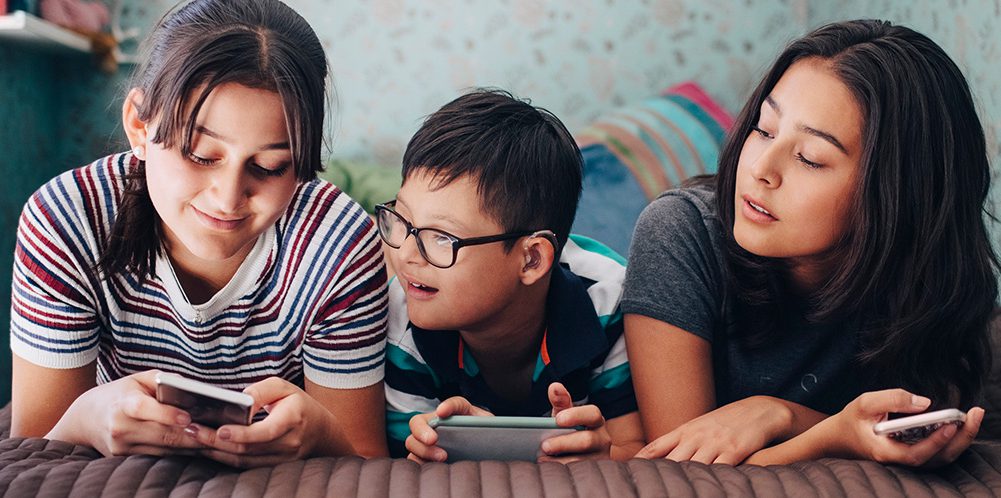Australia: Lockdowns force families to manage screen time


Screens weren’t a big part of Hilary Brainard’s household before the pandemic – she doesn’t even have a television – but these days she and her seven-year-old daughter spend their days hopping between Zoom calls and Google meetings.
The Sydney marketing manager is working full time while also supervising homeschooling and virtual extracurricular activities for her child, Emerson.
“It is definitely full on… It’s a necessity right now, [and] I wrote down a list of all the things that she’s doing on a screen, and it’s really long,” Brainard says.
There’s time spent using Google slides for school presentations, plus hours of Zoom assemblies and classes. And while Brainard is finishing her work day, her daughter is logging in to about six hours of after school programs each week, focusing on everything from ancient world studies to Mandarin.
“She also does YouTube for exercise. She’s using a screen, but she’s still learning,” Brainard says.
It’s quite a U-turn for Australian parents, who have spent the last two decades scrambling to limit the amount of time their children spend staring at devices. Federal guidelines suggest kids between 5 and 17 shouldn’t have more than 2 hours of recreational time on screens outside of school work.
But pandemic lockdowns have changed the game, with the virtual world now the only avenue open to many for learning and socialising. Students in Sydney and Melbourne have now completed multiple stints of homeschooling, and families have been forced to negotiate new screen time rules.
As screen time becomes more embedded, anxieties about the long-term health impacts of this prolonged usage are starting to emerge. A decision from China’s National Press and Publication Administration this week to limit children’s video game playing time to three hours per week has resonated with many Australian parents, who are increasingly concerned about whether children – who have spent so long chained to a screen – will be able to wean themselves off them once the lockdowns lift.
Chief executive of ASX-listed cyber-security company Family Zone, Tim Levy, says concerns about excessive technology use during the pandemic were exacerbated by the fact that the Australian schools system was not adequately prepared for remote learning last year.
Many schools stop families from installing their own parental control software on school devices, creating concerns about how kids might be using their screens during school time.
“In the lead up to June [last year] we had a lot of parents ringing us up, saying ‘this is mayhem’,” Levy says. “Parental control sales doubled April to June.”
Family Zone sells products to both schools and family homes, including tools to help manage time limits on gaming and internet use. Shares in the company are up almost 60 per cent over the past year.
Despite Australian families being more focused than ever on their screen time, Levy believes parents have found it more difficult in recent years to talk to their kids about cyber safety and managing their time behind the screen.
“They are jaded about it… Because parents are busy, tired and stressed, I think that’s one reason they steer clear.”
When his team talk to schools and families about staying safe online, Levy says the focus is on starting conversations as early as possible.
“When we talk to schools today, we start early, trying to create boundaries and safe behaviours for young kids.”
Brainard is keeping virtual activities diverse at home, and actively builds in screen-free time each week. “Every couple of days I just take her off the computer completely,” she says.
But making that switch isn’t always straightforward. “It’s like candy, kids love being in front of screens, so it’s not easy and there are definitely long discussions.”
Despite that challenge, the breadth of digital activities available has been a welcome feature, according to Brainard, with everything from personal finance classes to science experiments available online.
“I think she’s getting a bit of a rounder education at home, I think. We’re trying to look at these things as a positive,” Brainard says.
Expert in children and technology and senior lecturer at the University of Western Sydney Dr Joanne Orlando says keeping a diverse range of activities on offer is important. Australians need to move away from simply monitoring ‘screen time’ to monitoring the quality of the virtual experiences their children have, she says.
“One way of thinking about it is screen impact — not all screens are the same. If your child is on the screen, and they’re doing classes, the impact is probably good,” she says.
Setting up regular breaks across the day can help with balance, Dr Orlando says.
“It could be the time when you just have afternoon tea at home, or the time that you go and walk the dog. Something that is just that refresher time.”
Source: smh.com.au




